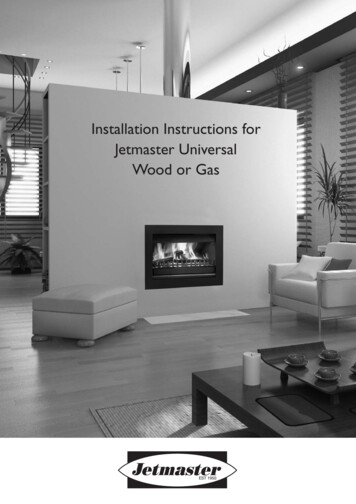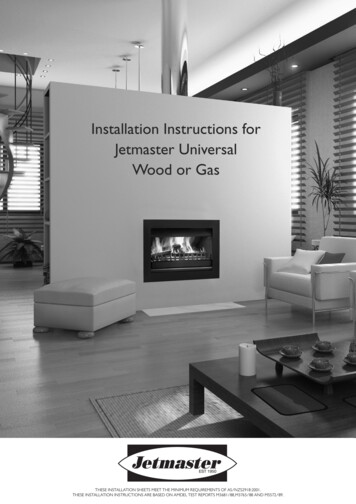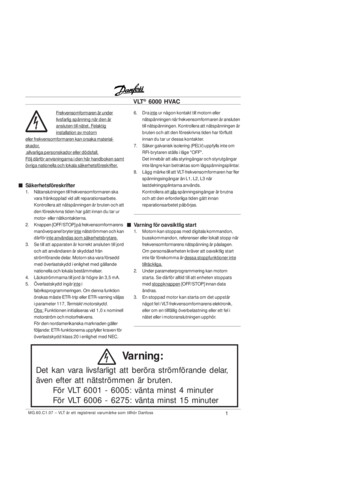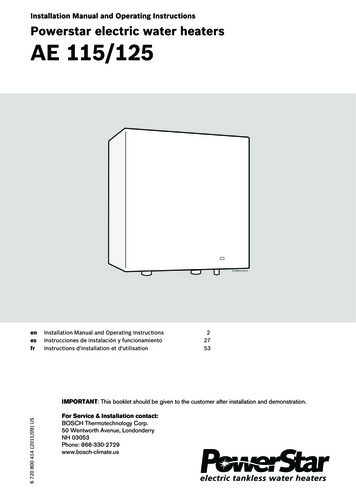
Transcription
Installation Instructions forJetmaster UniversalWood or Gas
IndexPage 2General Instructions - Timber frame installation Jetmaster Universal wood or gasPage 3Componentry and specificationsPage 4Frame out for Timber frame installationPage 5Timber frame installationPage 6Installation glossary timber frame installationPage 7Summary of minimum installation specificationsPage 8Installation diagram full brick chimneyPage 9Installation full brick chimneyPage 10Flue heights and terminationsPage 11Installation into existing fireplacePage 12TroubleshootingPage 13Fixing trims, fascias and mantelpiecesPage 14Using your wood fireplace
General Instructions Jetmaster Timber Frame Installation - Wood Or GasStep by step check listWarning! Please read these instructions carefully. Failure toadequately follow the instructions can result in serious injuryor death.1. Position firebox on a non-combustible hearth - see diagramNo 1 Hearth - Summary of minimum installation specs page7.2. Bolt gather to firebox.3. Insulate entire firebox and gather where painted red withthe insulation provided.4. If using a lintel bolt lintel to firebox –insulate between linteland firebox .You can lay your Hebel or brickwork directlyonto the top of the firebox between the gather and frontflange of the firebox. However it is important to insulatebetween the Hebel/brickwork and firebox.5. Ensure air intake area at bottom of unit is not obstructed.7. Brick or Hebel around firebox to a height 600mm abovethe firebox. Min 75mm Hebel block can be used.7. Do not recess the firebox by more than 110mm. A greaterdimension could result in convected heat loss.8. Use the double flue kit provided. Rivet inner active flue withuncrimped end facing down to collar of gather at three places.Rivet active flues together at crimped joins.Fix outer non-active flues to active inner flues use 3 x 25mmself-tapping screws through outer flue at bottom at each joinand on top at each join.As an alternative, rivet 4 x 25mm conduit saddles at each jointop and bottom.Ventilate the flues, cut 4 x 25mm notches at bottom of firstlength of outer flue and top of outer flue in either the ceilingcavity or just below the ceiling.When using a cover cone drilla series of holes into the outer flue below theCover cone, to ensure adequate ventilation. It’s important toensure airflow between the outer and active flues.Flue clearances: A minimum of 50mm clearance must bemaintained between outer flue and combustibles.9. A minimum of 3.6m of flue is to be used.10. Fit a recommended Jetmaster flue cowl to the top of flue.11. Gas burning. A ½ inch BSP inlet on right hand side isrequired. Drill at 100mm from base and rear of firebox fromoutside of firebox. Avoid penetrating the firebox from therear.PAGE 2
Componentry And SpecificationsFlueRotatingcowlFixedcowlGas cap20mmGATHER AND FIREBOX DIAGRAMS (DIMENSIONS IN MILLIMETERS)MODEL400440500600600 Low700S700SH Low700D850850 Low1050 Low Low10501200*1500*PAGE 145140120120120120120150150150180180150150
Frame Out For Timber Frame InstallationNB Frame out allows for 100mm of Hebel onsides and back of firebox with a 25mmclearance from the firebox and 600mm ofHebel above the firebox.NB It is preferable to install the Unit and fluesprior to Timber construction,so mistakes areminimized.All fronttimber studsto beinstalledon edgeElectricalsif requiredGasconnection(DIMENSIONS IN MILLIMETERS)MODELA400640440720500820600920600 Low920700SH1020700SH Low1020700D10208501170850 Low1170105013901050 Low 75525575575625625725725PAGE 4
Diagram for Timber Frame Installation - Wood or gas11,000 mm min2Flueclearances50 mm min3Double skin6Triple skin10 mm min458117913Hebel 600 mm aboveheight of firebox101920211412200 mm min100mm minmin forfor modelsmodels 1050- 1500100mm850–150026mm400–700D26mm minmin forfor modelsmodels 400- 85015300 mm min1816PAGE 517
Installation Jetmaster Universal Timber Frame Installation - Wood Or Gas1. Flue Termination. Choose from Rotating cowl. Fixed, DualFuel or Chinaman’s Hat.NB If using Chinaman’s Hat allow 120mm clearance from topof flue to hat.For gas installation use an approved AGA GAS COWL.2. Approved flashing.3. Rafters4. Inner Active flue5. Outer Flue6. If the clearance of the outer flue (5) is less than 50mm tocombustibles a second outer flue must be used and itsclearance must not be less than 10mm to combustibles. Keepthe same clearances for bends.7. Plasterboard: A 75mm clearance must be kept to the outerflange of the Firebox. If a flush finish or behind the flange finishis required then Villa board or the equivalent should be used.8. Combustible wall9. There must be a minimum of 100mm Hebel around thefirebox and it must be taken to at least 600mm above the topof the firebox. NB if using bricks then 115mm is requiredaround and 600mm above firebox.10.Timber stud11. Make 4 ventilation holes in the outer flue and if a 2ndouter is used repeat. Holes should be 25mm by 50mm each.Do not perforate the active inner flue.12. A 25mm air gap between Hebel/brickwork and thecombustible wall must be kept to allow air to flow behindbrickwork/Hebel and also into the outer flues.Enclosed cavities are not allowed if the combustible wall isremoved and the unit is installed against or through the brickwall, ventilation holes can be left in the hearth between thebrick walls and the unit. It is important for air to flow betweenthe flues.13. Insulation to wrap around the firebox where painted red.14. Air intake – Do not obstruct.15. Hearth (See diagram 1 Page 7 – Summary of minimuminstallation specs).16. 12mm AC Sheet17. Timber floor.18. Reinforced concrete footing-Generally not required witha Hebel installation.19. Insulate between top of firebox and Hebel/brick with theinsulation provided.20. If rendering keep a 2mm expansion gap to flange.21. For burning gas a ½ inch BSP inlet on RHS of firebox isrequired. Drill at 100mm from base and rear of firebox. Avoidpenetrating the convection chamber located at the rear ofthe firebox.PAGE 6
Summary Of Minimum Jetmaster Installation Specifications1. HearthAutoclaved aerated lightweight concrete block,or for hearths26mm thick FC Sheeting or any suitable non combustiblematerial like slate, granite or marble is acceptable.300mm MINJETMASTERSELECTED FINISHmustbe beminimum26mmthick. Models 400-850400–700Dmustminimum26mmthick.must bebe minimumminimum 100mm100mm thick.thick. This Models 1050-1500850–1500 mustincludes selected finish such as ceramic tiles, marble orgranite.100mm MIN (Models 850-1500)26mm MIN (Models 400-700D)BRICK ON EDGE Must project forward of aperture by a minimum of 300mm.BRICK ON FLATJETMASTER Must project either side of aperture by a minimum of200mm.300mm MIN.200mm MIN.2. Flue Single skin flue (stainless steel) must be enclosed with singleskin brickwork, concrete, or autoclaved aerated concreteblock. Twin skin flues (stainless steel inner, and galvanised outer)can either be left exposed or enclosed with stud walls andsheet plaster or timber.A minimum of 50mm clearance mustbe maintained between the outer flue and any combustibles.If using double skin flues space inner and outer flues using3x25mm self tapping screws through outer casing atbottom, at each join and at top. Also ensure that flues areventilated at top and bottom, and when using a cover conedrill a series of holes into the outer flue below the covercone to ensure adequate ventilation.SINGLE SKINSTAINLESS FLUE50mm MIN.CLEARANCETWIN SKIN FLUESTAINLESS INNERGALVANISED OUTER Fit cowl to flue or chimney breast.3. Enclosure A minimum of single skin brickwork, concrete, or autoclavedaerated concrete block must surround the firebox andgather at back, sides and front. A minimum of 25mm air gapfilled with insulation material provided must be maintained.PAGE 725mm MIN.INSULATIONBRICKWORK
Installation Instructions Full Brick ChimneyALTERNATIVEBRICK CHIMNEYTERMINATIONSplayed renderto disperse rainwateraway from top of flue1214Fibre cement‘collar’around flue1010112 230x172mmchimney openings(min size)Isometric viewBrick capping(20mm overhang)102 350x172mmchimney openings (min size)NOTE: If chimney is morethan 950mm widethen two outlets only arequite practical on the longside of chimney - width ofoutlet to be widened inaccordance with the lengthof the chimney913Provide outer sleeveto allow for expansionand contraction ofactive flue75678Fibre cement sheetsof sufficient thicknessto support brick cappingand splayed render andto provide a collar torestrain top of flueStainless steelflue41532211SectionPAGE 8
Installation With Full Brick ChimneyStep by step check listWarning! Please read these instructions carefully. Failure toadequately follow the instructions can result in serious injuryor death.1. Position firebox on a non-combustible hearth-see diagram1 page 7 (summary of minimum installation specs.)Installation with full brickchimney1. Re-inforced concrete foundation.Suspended floors will require supports and footings.2. Hearth.2. Bolt gather to firebox.3. Air inlet. DO NOT BLOCK.3. Insulate entire firebox and gather where painted red withthe insulation provided.4. Firebox.4. If using a Jetmaster lintel, bolt lintel to firebox. If using anangle bar as a lintel you can use the side Hebel or brickworkto support the lintel - insulate between lintel and firebox.Youcan lay your Hebel or brickwork directly onto the top of thefirebox between the gather and front flange of the firebox.However it is important to insulate between the brickworkand firebox.6. Optional lintel, as firebox supports brick wall. (If other thanthe Jetmaster lintel used, a 100 x 10 angle bar is needed andallow at least 2 mm for expansion.5. Ensure air intake area at bottom of unit is not obstructed6. Brick around firebox7. Do not recess the firebox by more than 110mm. A greaterdimension could result in compromise in convected heat.8. Rivet inner active flue with uncrimped end facing down tocollar of gather at three places.Rivet active flues together at crimped joins.Encase the flue with brickwork and it is suggested that a pieceof 9mm fibre cement sheeting with a circular cut out toaccommodate the flue be positioned on the chimney opening,one course of brickwork from the top of the chimney. Slopemortar outward from the flue which should protrude throughthe cement sheet by 50mm (see diagram page 7 alternativebrick chimney termination.9. Fit a recommended Jetmaster flue cowl to the top ofchimney.10. Gas burning - A ½ inch BSP inlet on right hand side isrequired. Drill at 100mm from base and rear of firebox fromoutside of firebox. Avoid penetrating the firebox from therear.PAGE 95. Gather.7. Insulation.8. 115 minimum brickwork.9. Gap between stainless steel flue and brickwork may(optional) be filled with mortar (8 sand, 3 lime, 1 cement).10. Approved Flashing.11. Drip tray.12. Jetmaster stationary cowl, rotating cowl, (also see diagramalternative brick termination-this page) A.G.A gas approvedcowl when using gas.13. Optional 45 degree bends or offset gather available.14. Fibre cement sheet under last course of bricks with holecut to restrain flue. Provide outer sleeve to allow forexpansion and contraction of active flue and base cowl whenfilling with mortar.15. For burning gas: 1/2-inch B.S.P. inlet on right hand side offirebox is recommended. Drill at 100 mm from base and rearof the firebox measuring on outside of firebox.Important points Do not block air inlet. Cover all surfaces of fireplace,including, gather, with insulation provided. Build the brickwork at the back and sides of the fireplaceagainst insulation. Seal any gaps between gather and fireboxwith the fire cement or insulation provided.
Flue Heights & Flue Termination3.6 metres or greaterRidge Line1 metreminimumLess than 3.6 metresRidge LineExtend flue 400mmabove ridge line50mmclearancebetween roofingmaterials&any othercombustiblematerials1 metre minFlue CowlAGA approvedto AG604500mmminGas BurningFlue TerminationPAGE 10
Installation Into An Existing FireplacePlease read these instructions before beginningStep by step checklist1. Check the chimney for cracks, cavities and blockages andrepair these. The size of the Jetmaster Firebox is determinedby the minimum dimensions of the chimney flue.Minimum flues areas are3. Repair any cracks or cavities in the recess especially if it hasbeen chopped out to accommodate a specified unit size, andthe cavity between a double brick wall has been exposed.N.B. No metal gather is required. The Jetmaster is designedto operate in existing fireplaces without using the gather ormetal flues.4. Tape the insulation to back and sides of the Jetmaster andslide into position, taking care not to snag the fibreglassinsulation against the sides.Model 500, 600, 700sh- 400 cm2Model 700D, 850-450 cm2Ensure that this area is maintained throughout the entirechimney.The check:Flues that are 10% smaller than this will work depending onthe height of the chimney. Chimney pots that are too smallshould be removed. Stainless steel flues may be used if thechimney is in poor condition.B. The two smoke outlets on the firebox marry up with theexisting chimney. (There must be a 200 mm minimum to anyoverhang above smoke outlets).2. Measure the width, depth height of the recess.The followingtable lists the minimum dimensions of the recess for each unit.UNIT SIZE WIDTH500550600650600 Low650700SH750700 Low750700D750850900850 Low900105010501050 0640590640590690740690790690 Allow 25mm on each side of the firebox insulationA. Recess too large:1) The recess can be reduced by inserting bricks or Hebel atthe sides and/or back, and where necessary between the topof the unit and the underside of the lintel.The existing hearthcan also be built up either with bricks or by forming a plinth.II) Use Jetmaster fascias and trims to seals gaps less than 75mm between sides and top of the unit and masonry.B. Recess too small: The recess can be made deeper byremoving the rollback and smoke shelf. If the height is too low,remove the lintel and replace at the required height. If thesides have to be removed it is suggested an experiencedbuilder to do the work as the sides support inner flues of thechimney.NOTE Allow 1 mm expansion gap for all materials.PAGE 11A. Do not recess the unit by more than 110 mm.C. Do not obstruct air intake at the bottom of the unit.5. At this stage block the gaps between the unit and recesswith pieces of cardboard and have a test fire using paper only.If continuous smoking occurs, check size of chimney potsagain. Also check for blockages in the chimney.“Downdraught” (wind blowing down the chimney isrecognised by occasional puffs of smoke. In this case useJetmaster rotating cowl. If smoking persists a smallerJetmaster will have to be used.6. Seal unit into position with the masonry, fascias or trims,ensuring any air leak around frame is limited. Allow masonrywork to cure for a minimum of three days.See next page for diagrams.
Installation Into An Existing Fireplace1aIf masonry overhangsthe smokeholes theremust be at least a 200mmclearance above the unitGap from lintelto be bricked orfirebox raisedSmokeshelfInsulationRollbackExisting fireplacerecess and chimneyHearth2If recess is too small removeRollback and Smokeshelfas below3B. Fireplace recess too large(more than 75mm) - use bricksto build up and reduce sizeA. Fireplace recess slightly too large(less than 75mm) - pack with withextra fibreglass insulation1bFibreglass insulation(supplied)N.B. No metalgather requiredAllow 1mm expansion gapfor all materialsSealSmoke outletsNot recessed bymore than 110mmJetmastermantelpieces have20mm or 100mmrebateHearthFibreglass insulationAir intake must notbe obstructedGaps greater than 75mmto be bricked. If less than 75mmJetmaster fascias and trims canbe used to cover the gapInfill strips of marble/sone/tiles10mm overlap infront or behind frameFireplace surround(i.e. mantelpiece)Troubleshooting1. Check that the gather is sealed to the firebox.2. Check chimney. If chimney is closer than 3 meters to theapex of roof, the chimney should extend approximately350mm past the apex. Chimney should be a minimum of 3.6meters from the top of the gather.Recommended flue sizes.UNIT500/600/700S700 DEEP8501050FLUE SIZERound(diam. mm)200225250300FLUE SIZESquare(mm)225x225250x250250x250300x3003.The cross section area of flue should be within 100% of therecommended size through its lengths and preferably straight.The angle of any bend should be more than 45% degrees.Chimney pots, which are too small to allow free flow, andmortar droppings at flue bends, are frequent causes ofsmoking.4. Check smoke outlet.With the damper fully open, check formortar dropping over the smoke outlet. Such mortar can beremoved with a long cold chisel.5. Check ‘False’ drafts entering around side of firebox / fascia/ mantelpiece into cavity. Use fiberglass wool to prevent airmovement.6. Check air intake is not obstructed.7. Check damper properly located on pivot-pins.PAGE 12
Fixing Trims, Fascias and MantelpiecesTrims1. Score the back of the stainless steel or mild steel trim andthe surface to which the trim will be attached, to allow thetwo surfaces to adhere well to each other.Attach trim to flange offirebox with heat resistantsilicon (roof and guttersilicon is recommended)2. Place a bead of Silicone onto the back of the stainless steeltrim.3. Place another bead of Liquid Nails around the outer edgeof the frame. Thiswill cure quickly and hold the frame into position.4. Clamp the trim onto the unit for 24 hours until theadhesives have curedAttaching FasciasUse masonry plugs and drill through corners of fascia andattach to bricks or masonry.If attaching to plasterboard use suitable toggles If neither ofthe above is suitable, then use heat resistant bonding silicon.N.B. Mantelpiece will hold fascia in position.It may be necessary to leave fascia up to 10mm out of cavityto allow for flush fitting with mantelpiece. Use fibreglass woolto block gaps between fascia and cavity surrounds.Fitting ScreensClip on ScreensFor standard flange, square fascias and trims (Hang flush withopening. Locate lugs between flange and louvre).Attaching MantelpiecesIf fascia fits flush with wall no rebate on mantelpiece isnecessary.If fascia sits proud of wall, a rebate on mantelpiece isnecessary. Most Jetmaster mantelpieces come with a 20mmrebate.When mounting a mantel-piece, use mirror hooks or othersuitable fixing brackets.PAGE 13Cast iron fascias canbe bolted and fixed tothe plasterboard orbrickwork behindfirebox
Using Your Wood Fired Jetmaster UniversalHow to use the woodfireplaceYour Jetmaster fireplace is designed not to smoke and byfollowing a few instructions you will achieve optimum heatoutput, convenience and fuel economy.Please note that the first fire could result in a few odourscoming from the firebox. Do not be alarmed. This is notunusual when first using a metal finished product and will sooncease.Lighting a fire1. Using a number of crumpled sheets of newspaper, somekindling and a few small split logs arrange your fire in a “Tepeetent” style.2. With the tool provided, fully open the DAMPER by pullingthe control lever towards you. (Not always applicable withDouble Sided Firebox.)3. Light the fire at both ends as well as at the centre.4.When the kindling and small split logs are burning well, startto build up your fire with larger split logs.5. When the fire is well established you can start closing theDamper.The amount you can close it will depend on the typeof wood used and the general weather conditions.Experience will soon show you how far; however, the dampershould never be closed more than half way.6. When the fire has gone out completely, you can close theDamper fully thus preventing any loss of heat from the roomup the chimney.CleaningGeneral MaintenanceThe visible parts of your Jetmaster can be cleaned with adamp cloth or soft brush. Should you wish you could repaintthe unit with a heat resistant paint?SafetyThe Jetmaster is a safety-tested unit. However, you must neverleave an open fire unguarded. Jetmaster has a screen that isdesigned to prevent sparks leaving the fireplace and veryresistant to being accidentally knocked over by youngchildren.Fuels1. Medium density woods are preferred for open fireplaces.Softer woods (Pines etc) burn fast, leaving a lot of ash andcreosote. Hard woods (Red Gum etc) can be best used whenmixed with medium woods and should not be used to start afire.2. A split log will burn better than a full log.3.Wood should be stored (seasoned) in a dry ventilated areafor at least 12 months.“Green” wood can have 50% moisture, which results in a verypoor heat emission. Box woods (e.g. Grey Box and YellowBox) are highly recommended as they produce fine coals.Burning well seasoned medium density wood is the mostimportant step towards achieving optimum results from yourJetmaster!Gas FiresSee separate installation manual with gas burner.1. The Jetmaster Log Pan is designed to give greater heat andfuel efficiency. For the duration of the cold season the LogPan should never be emptied. The resulting bed of ash andcoals from previous fires will soon become a heat bankgenerating more heat than the burning logs.This ash bed alsoinsulates and greatly extends the life of the Log Pan. This iswhy an ash bed must be maintained at all times.When the level of the ash bed becomes too high, the top layercan be removed.Depending on frequency of use and quality of wood, thisskimming procedure should not be required more than onceor twice a Season!2.To prevent chimney fires as well as enabling the chimney todraw properly, the chimney/flue should be swept at least oncea season, subject to the quality of timber used in the fire.PAGE 14
Back PagePAGE 15
between the Hebel/brickwork and firebox. 5. Ensure air intake area at bottom of unit is not obstructed. 7. Brick or Hebel around firebox to a height 600mm above the firebox. Min 75mm Hebel block can be used. 7. Do not recess the firebox by more than 110mm. A greater dimension could result in convected heat loss. 8. Use the double flue kit provided.










